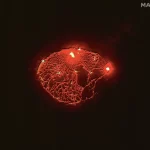Key Takeaways:
- Dying stars emit colossal gas cocoons that might produce gravitational waves, distinct from black hole collisions detected by LIGO.
- Groundbreaking simulations by Northwestern University researchers reveal that these gas cocoons, formed during a star’s collapse, could generate detectable gravitational waves.
- Traditional gravitational wave detection has focused on binary systems; this discovery opens doors to identifying waves from individual celestial objects.
- Gas cocoons result from collapsing stars ejecting high-speed particles, disrupting the conventional understanding of gravitational wave sources.
- If confirmed by LIGO, observing these gas cocoons through gravitational waves offers unprecedented insights into dying stars’ inner workings and their ultimate demise.
Recent astronomical simulations conducted by Northwestern University scientists shed light on a remarkable phenomenon: dying stars don’t just collapse into black holes; they birth colossal “cocoons” of gas that may ripple through space-time, creating gravitational waves. While gravitational waves, previously detected by instruments like LIGO, were mostly attributed to black hole collisions, this revelation introduces a new cosmic symphony.

The announcement of the first direct detection of gravitational waves in 2016 marked a turning point in astronomy. Instruments like LIGO have since captured nearly a hundred instances of black hole mergers, showcasing the cosmic dance that sends gravitational ripples across the universe. However, these new simulations suggest an additional cosmic orchestra—cocoons of tumultuous gas unleashed by dying stars.
The groundbreaking research, presented at the American Astronomical Society‘s 242nd meeting, offers insights into how dying massive stars create gravitational waves. Contrary to previous assumptions that gravitational waves primarily originate from black hole mergers or neutron star collisions, these simulations propose an alternative celestial source: the agitated gas cocoons.
As massive stars exhaust their fuel and collapse into black holes, they expel jets of ultra-fast particles. Initially, astronomers hypothesized that these jets might be the origin of gravitational waves. Yet, the simulations unveiled a surprising protagonist: the cocoon formed when the outer layers of the collapsing star interact with the powerful jets.
Lead researcher from Northwestern’s Center for Interdisciplinary Exploration and Research in Astrophysics highlighted the unexpected discovery. “When I calculated the gravitational waves from the vicinity of the black hole, I found another source disrupting my calculations — the cocoon,” Gottlieb explained. This cocoon, a turbulent mass of gas, emerges from the interaction between the collapsing star’s layers and the intense jets.
Describing the process, Gottlieb likened it to drilling a hole into a wall, where the spinning drill bit causes debris to spill out. Similarly, the high-powered jets puncture the star, heating and expelling its material, forming the cocoon’s hot layers. Surprisingly, this roiling material within the cocoon mirrors the conditions necessary for generating detectable gravitational waves.
Gottlieb’s calculations propose that LIGO might soon detect these gravitational waves during its upcoming observations. Moreover, the emissions from these gas cocoons emit light, offering a dual opportunity for astronomers: to gather information through both gravitational waves and telescopic observations, a concept known as multi-messenger astronomy.
The potential detection of a cocoon by LIGO heralds a fascinating chapter in understanding stellar interiors and their ultimate fate. It could mark the first instance of detecting gravitational waves from a singular celestial object rather than from the interaction between binary objects orbiting each other, as previously observed by LIGO.
“While LIGO has so far detected gravitational waves from binary systems, the discovery of a non-binary source is imminent,” Gottlieb stated. He emphasized the significance of investigating cocoons as a prime candidate for such distinct gravitational wave sources.
Although the research is pending publication in a peer-reviewed journal, its implications promise an extraordinary shift in how we perceive dying stars and the cosmic symphonies they compose.


